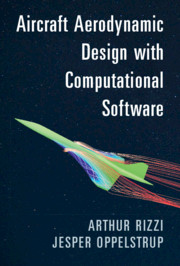Book contents
- Frontmatter
- Contents
- List of Figures
- List of Tables
- Preface
- Acknowledgements
- Abbreviations
- Nomenclature
- 1 Introduction to Aircraft Aerodynamic Design
- 2 Airflow Physics and Mathematical Models
- 3 Concepts and Computational Models in Wing Design
- 4 Finite-Volume Schemes for the Euler Equations
- 5 Airframe Computer-Aided Design and Automated Grid Generation
- 6 Computational Fluid Dynamics for Steady and Unsteady Flows
- 7 Fast Computation of Airfoil Flow
- 8 Airfoil Design Considerations
- 9 Wing Design Considerations
- 10 Configuration Development and Flying Qualities
- 11 Airload–Structure Interactions and Aero–Elastic Effects
- Index
6 - Computational Fluid Dynamics for Steady and Unsteady Flows
Published online by Cambridge University Press: 30 April 2021
- Frontmatter
- Contents
- List of Figures
- List of Tables
- Preface
- Acknowledgements
- Abbreviations
- Nomenclature
- 1 Introduction to Aircraft Aerodynamic Design
- 2 Airflow Physics and Mathematical Models
- 3 Concepts and Computational Models in Wing Design
- 4 Finite-Volume Schemes for the Euler Equations
- 5 Airframe Computer-Aided Design and Automated Grid Generation
- 6 Computational Fluid Dynamics for Steady and Unsteady Flows
- 7 Fast Computation of Airfoil Flow
- 8 Airfoil Design Considerations
- 9 Wing Design Considerations
- 10 Configuration Development and Flying Qualities
- 11 Airload–Structure Interactions and Aero–Elastic Effects
- Index
Summary
The knowledge gained in the previous two chapters leads to procedures for computing solutions to the Navier–Stokes equations in 2D and 3D. Chapter 6 explains the major components and functions of a typical Reynolds-averaged Navier–Stokes (RANS) code, including the modeling of turbulence in steady or unsteady flows. Convergence acceleration devices, including multigrid techniques, are explained. Finite-volume formulation and standard physical modeling for turbulence yields the RANS equations used in most computational fluid dynamics (CFD) codes directed toward compressible-flow aeronautical applications. By taking the reader through a RANS application step by step, this chapter illustrates the process that an informed CFD user needs to know for applying a typical code of this genus to aerodynamic design. Two practical cases of transonic flow over an airfoil – one in steady flow and the other in unsteady buffeting flow – demonstrate execution of the workflow. Computing a Mach sweep across the entire transonic regime, the steady-flow example exhibits the nonlinear phenomenon of shock stall. Mastering this chapter makes the student a reasonably well-informed CFD user who understands how to carry out a sensitivity analysis to demonstrate CFD due diligence.
Keywords
- Type
- Chapter
- Information
- Aircraft Aerodynamic Design with Computational Software , pp. 213 - 246Publisher: Cambridge University PressPrint publication year: 2021

